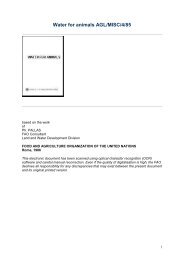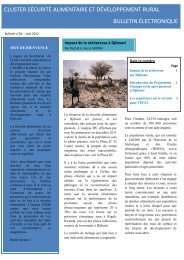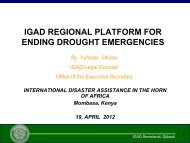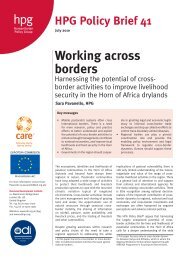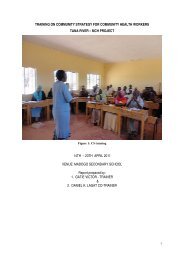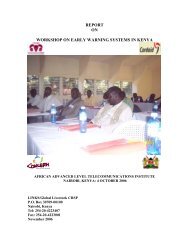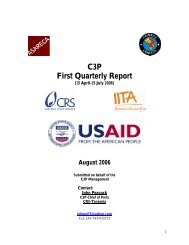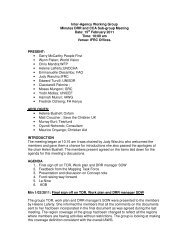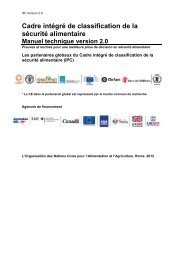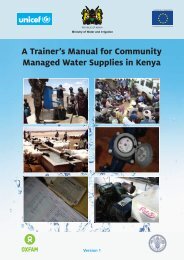Synthesis of Existing Knowledge and Experience on the Provision of ...
Synthesis of Existing Knowledge and Experience on the Provision of ...
Synthesis of Existing Knowledge and Experience on the Provision of ...
Create successful ePaper yourself
Turn your PDF publications into a flip-book with our unique Google optimized e-Paper software.
In sum, pastoralism as a livelihood is a highly evolved ec<strong>on</strong>omic, social, cultural, <str<strong>on</strong>g>and</str<strong>on</strong>g> politicalresp<strong>on</strong>se to a l<str<strong>on</strong>g>and</str<strong>on</strong>g>scape where natural resources are highly variable in space <str<strong>on</strong>g>and</str<strong>on</strong>g> time. Insufficientattenti<strong>on</strong> to how pastoralists use <str<strong>on</strong>g>and</str<strong>on</strong>g> manage natural resources within this broader livelihoodc<strong>on</strong>text, <str<strong>on</strong>g>and</str<strong>on</strong>g> <strong>the</strong> lack <str<strong>on</strong>g>of</str<strong>on</strong>g> a coherent <str<strong>on</strong>g>and</str<strong>on</strong>g> streamlined approach to water development, <str<strong>on</strong>g>of</str<strong>on</strong>g>ten results inwater interventi<strong>on</strong>s which c<strong>on</strong>tribute to <strong>the</strong> disrupti<strong>on</strong> <str<strong>on</strong>g>of</str<strong>on</strong>g> elaborate <str<strong>on</strong>g>and</str<strong>on</strong>g> highly developed naturalresource management systems, <strong>the</strong> promoti<strong>on</strong> <str<strong>on</strong>g>of</str<strong>on</strong>g> unsustainable l<str<strong>on</strong>g>and</str<strong>on</strong>g> use, <str<strong>on</strong>g>and</str<strong>on</strong>g> heightened potentialfor c<strong>on</strong>flict, which serves to damage a very productive part <str<strong>on</strong>g>of</str<strong>on</strong>g> Ethiopia’s ec<strong>on</strong>omy. The ir<strong>on</strong>y <str<strong>on</strong>g>of</str<strong>on</strong>g>developing water to satisfy dem<str<strong>on</strong>g>and</str<strong>on</strong>g> is that as much as it can alleviate immediate pressures in <strong>the</strong>short term, it can potentially bring with it lasting <str<strong>on</strong>g>and</str<strong>on</strong>g> serious negative impacts in <strong>the</strong> l<strong>on</strong>g term. Thisoccurs when local needs, l<str<strong>on</strong>g>and</str<strong>on</strong>g> use patterns <str<strong>on</strong>g>and</str<strong>on</strong>g> ecological functi<strong>on</strong>s are not sufficiently c<strong>on</strong>sidered.In turn, water development can potentially undermine ra<strong>the</strong>r than promote development <str<strong>on</strong>g>and</str<strong>on</strong>g>sustainable livelihoods.Ways forwardThe type, size <str<strong>on</strong>g>and</str<strong>on</strong>g> placement <str<strong>on</strong>g>of</str<strong>on</strong>g> water points requires a solid underst<str<strong>on</strong>g>and</str<strong>on</strong>g>ing <str<strong>on</strong>g>of</str<strong>on</strong>g> 1) water needs <str<strong>on</strong>g>and</str<strong>on</strong>g>c<strong>on</strong>cerns in a given area, 2) <strong>the</strong> natural resource base which might be affected - as water points“functi<strong>on</strong> within <strong>the</strong> natural envir<strong>on</strong>ment <str<strong>on</strong>g>and</str<strong>on</strong>g> can potentially have significant harmful effects <strong>on</strong> it <str<strong>on</strong>g>and</str<strong>on</strong>g><strong>on</strong> <strong>the</strong> welfare <str<strong>on</strong>g>of</str<strong>on</strong>g> people depending <strong>on</strong> it” (Warner <str<strong>on</strong>g>and</str<strong>on</strong>g> Abate, 2005: 13), 3) <strong>the</strong> social as well aspolitical dynamics in areas <str<strong>on</strong>g>of</str<strong>on</strong>g> interventi<strong>on</strong>, 4) capacity at <strong>the</strong> local level to manage, operate <str<strong>on</strong>g>and</str<strong>on</strong>g>maintain water points, <str<strong>on</strong>g>and</str<strong>on</strong>g> 5) existing traditi<strong>on</strong>al water management systems already in place.Underst<str<strong>on</strong>g>and</str<strong>on</strong>g>ing <str<strong>on</strong>g>and</str<strong>on</strong>g> building <strong>on</strong> <strong>the</strong>se key elements is fundamental to help ensure that water schemeswill satisfy dem<str<strong>on</strong>g>and</str<strong>on</strong>g>, remain functi<strong>on</strong>al, <str<strong>on</strong>g>and</str<strong>on</strong>g> minimize envir<strong>on</strong>mental degradati<strong>on</strong> <str<strong>on</strong>g>and</str<strong>on</strong>g> c<strong>on</strong>flict. Thisnecessitates bringing communities <strong>on</strong> board at <strong>the</strong> outset <str<strong>on</strong>g>of</str<strong>on</strong>g> any planned interventi<strong>on</strong>.Following is an amalgamati<strong>on</strong> <str<strong>on</strong>g>of</str<strong>on</strong>g> three sets <str<strong>on</strong>g>of</str<strong>on</strong>g> guidelines 60 which could serve as a starting point toaddress <strong>the</strong> above issues. This example could also serve as a starting point to discuss <str<strong>on</strong>g>and</str<strong>on</strong>g> build <strong>on</strong> inorder to develop a comm<strong>on</strong> set <str<strong>on</strong>g>of</str<strong>on</strong>g> water development guidelines suited to <strong>the</strong> pastoral c<strong>on</strong>text 61 .1) Planning:Local needs, opportunities <str<strong>on</strong>g>and</str<strong>on</strong>g> existing water management systems need to be understood during<strong>the</strong> planning stage <str<strong>on</strong>g>of</str<strong>on</strong>g> any water interventi<strong>on</strong>. The planning stage is critical <str<strong>on</strong>g>and</str<strong>on</strong>g> <str<strong>on</strong>g>of</str<strong>on</strong>g>ten requiresc<strong>on</strong>siderable time <str<strong>on</strong>g>and</str<strong>on</strong>g> effort (6-12 m<strong>on</strong>ths for l<strong>on</strong>g-term development planning) to make sure that<strong>the</strong> interventi<strong>on</strong> is appropriate, will satisfy dem<str<strong>on</strong>g>and</str<strong>on</strong>g>, <str<strong>on</strong>g>and</str<strong>on</strong>g> will be sustainable in <strong>the</strong> l<strong>on</strong>g-term.Stakeholder mapping• Perform a comprehensive stakeholder analysis at local level to underst<str<strong>on</strong>g>and</str<strong>on</strong>g> who <strong>the</strong> differentpotential resource users are (<strong>the</strong> ‘community’ who will benefit) <str<strong>on</strong>g>and</str<strong>on</strong>g> also who may st<str<strong>on</strong>g>and</str<strong>on</strong>g> to gainor lose from water interventi<strong>on</strong>s (for example upstream <str<strong>on</strong>g>and</str<strong>on</strong>g> downstream users al<strong>on</strong>g rivers).Also explore current access patterns to water to identify whe<strong>the</strong>r <strong>the</strong>re are social (or o<strong>the</strong>r)c<strong>on</strong>straints limiting access <str<strong>on</strong>g>of</str<strong>on</strong>g> some groups to water.oIdentify local customary instituti<strong>on</strong>s <str<strong>on</strong>g>and</str<strong>on</strong>g> representatives <str<strong>on</strong>g>and</str<strong>on</strong>g> underst<str<strong>on</strong>g>and</str<strong>on</strong>g> existing watermanagement strategies <str<strong>on</strong>g>and</str<strong>on</strong>g> relati<strong>on</strong>ships between groups. Engaging with communityleaders in an area is important to avoid c<strong>on</strong>flict over water points.60 See Warner, D. <str<strong>on</strong>g>and</str<strong>on</strong>g> Abate, C. (2005); Thorne, P. (2009); Ministry <str<strong>on</strong>g>of</str<strong>on</strong>g> Agriculture <str<strong>on</strong>g>and</str<strong>on</strong>g> Rural Development(2008).61 This set <str<strong>on</strong>g>of</str<strong>on</strong>g> guidelines serves <strong>on</strong>ly as an example to kick-start dialogue <str<strong>on</strong>g>and</str<strong>on</strong>g> is by no means a representati<strong>on</strong><str<strong>on</strong>g>of</str<strong>on</strong>g> <strong>the</strong> full set <str<strong>on</strong>g>of</str<strong>on</strong>g> existing guidelines previously presented.82



